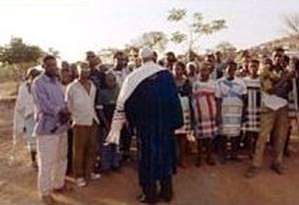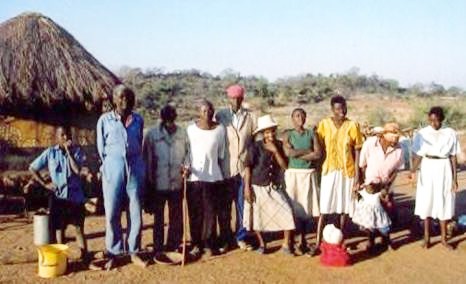 The Lemba, also known as Ba-lemba, Ba-soni, or Va-mwenye, is a Negroid race of people who for a long time have been claiming to be a lost tribe of ancient Israel.
The Lemba, also known as Ba-lemba, Ba-soni, or Va-mwenye, is a Negroid race of people who for a long time have been claiming to be a lost tribe of ancient Israel.
They insist that their ancestors are descendants from the ancient Israelites or more specifically from Abraham, Isaac, and Jacob who are their blood relatives, and claim priestly descent from the Biblical Aaron, brother of Moses. They also proclaim to be a branch of the ancient Yemenite Jews from a place called Senna.
Lemba oral history which has been passed down from generation to generation, states that they were led out of the Holy Land (Judea /Ancient Israel) by a high priest named Bhuba, and settled in Yemen where they built the city of Senna. Some 3,000 years ago, they sailed across the Arabian Sea “guided by a star sent by God” from Yemen to Afrika, where one group went to Ethiopia and the others migrated to territories of the Northern Province: Mozambique, Tanzania, Malawi, Kenya, Southern Zimbabwe and South Afrika, where they lived among the gentiles in peace. In (Ophir) Zimbabwe they helped to construct the great stone city which they identified as Great Zimbabwe, the ruins of which have captivated archaeologists for hundreds of years. On top of a hill they built a fort and a place of worship to their God Mwali (Mwari), Creator of all things.
The Lemba people, whose tribal emblem is an elephant inside the six-pointed Star of David, resemble the Bantu tribes, and though their lives for the most part are traditionally Afrikan, they observe certain customs which connect them to the Israelites. For example, the Lemba with their Semitic tribal names, follow the strict dietary rules laid down by Moses, observing kosher-like dietary restrictions, male circumcision rites, the ritual slaughter of animals where all blood must be drained before being considered fit for consumption, and strict rules against intermarriage. They avoid eating pork and meat from pig-like animals (like the hippopotamus), consuming only fish with scales, and they do not mix meat and milk. Other Lemba practices that adhere to Jewish religious tradition include observing a holy day each week, and wearing prayer shawls.
They have always followed the Old Testament, but during colonial times, the missionaries in Afrika forced many to study the New Testament, insisting that the only way to obtain a proper education was in the Christian schools. Anthropologists came to the conclusion that the Lemba had acquired their practices when white missionaries taught them about the Hebrew Bible, but geneticists have found that many Lemba men carry DNA sequences that are unique to kohanim – those Jewish priests believed to have descended from Moses' brother, Aaron.
The Lemba practice Hebraism and not what Western Jews identify as Judaism, since they adhere to a large number of cultural practices that are credited to the ancient Israelites, and have excluded those who have converted to Judaism in recent times.
The Lemba’s restrictions on intermarriage with non-Lembas made it particularly difficult for a male non-Lemba to become a member of the group, as Lemba women were forbidden from marrying outside the tribe. In earlier days, one could only be a Lemba by birth, but since this is no longer the case, Lemba men can convert non-Lemba women to their customs, and non-Lemba men who wish to marry a Lemba woman has to undergo circumcision and a purification process. This means that if there were intermarriages with different Jewish traders hundreds of years ago, it still could not explain the findings related to Lemba DNA signatures as speculated by some historians.
There are many groups around the world that practice Judaic rituals and claim to have descended from Biblical tribes, but they do not have any type of ancestral Jewish connection. The claim of the Lemba to Jewish origin on the other hand has received solid support in this regard, since the body of DNA evidence emphatically proves it.
A team of geneticists from the Centre for Genetic Anthropology at University College London were looking for a genetic comparison to the Lemba's claim to Jewish heritage, so, using a fairly recent procedure in genetic studies, they were able to identify a particular series of genetic markers on the Y chromosome of Lemba males which were then compared to other groups with whom the Lemba might have shared a common ancestor in ancient times.
DNA samples were also collected from the Bantu (Afrikan), Yemeni (Arab), Sephardic Jews and Ashkenazi Jews - including the Jewish priesthood from both communities - to compare the amount of similarity that existed among each group. The reason is that the more similar the Y chromosome is, the more closely related are the individuals from different groups to a common paternal ancestor.
Test results have confirmed that in a specific Lemba group known as the Bhuba Clan, so named after their original Jewish ancestor Bhuba, that 53.8 % of the male Lemba leaders carry the unique DNA Y chromosome modal haplotype signature of Jewish priests called the Kohen (Cohen). This chromosome is known to be characteristic of the paternally inherited Jewish priesthood known as the Cohanim (Kohanim).
Haplotype is the contraction of “haploid genotype".” It is the genetic make-up of an individual chromosome which is inherited together and not easily separable by recombination. In the human genome, haplotypes are produced by the molecular processes of sexual reproduction and by the history of the species. It is the male paternal bloodline with whom he mainly shares the same Y chromosome. In contrast to other haplotypes, those of the Y chromosomes do not come in pairs, so each human male has only one copy of that chromosome. Haplotypes can therefore be used to compare and define different genetic populations, and are usually geographically located.
This particular chromosomal gene is a distinct signature haplotype of Judaic origin that is similar to what exists in major Jewish populations who trace their ancestry to the priests of the ancient Jewish Temple and ultimately to Aaron, the older brother of Moses. This is a significant finding, since only 10% of the main male Jewish population carries this Kohen haplotype, which corroborates the Jewish belief that only ten percent of the population were descendants of Aaron. This Kohen genetic signature is completely absent in gentiles or non-Jewish people.
Lemba males carry a higher concentration of this Jewish priestly DNA chromosome than the European and American Jewish population, and are therefore more Jewish than the European and American Jews. Although the Bhuba tribe has this Kohen haplotype in higher percentages than the Ashkenazi priests, the non-Bhuba Lemba still has the highest percentage of this Kohen haplotype outside of the priestly order of Cohanim. This means that it is still higher than the Ashkenazim and Sephardim groups combined.

LEMBA TRIBESMEN
The discovery of these common DNA sequences originated from research conducted by geneticists in the United States, Israel and England, who wondered what truth there was in relation to the Jewish belief that the priests were descendants of Aaron. The analysis of the male Y chromosome showed that a particular pattern of DNA mutations was far more common among Cohanim priests than among lay Jews, so in studying the priesthood, this tool for distinguishing Jewish from non-Jewish populations was discovered. Unlike in other chromosomes, the genetic material of the Y chromosome remains basically unchanged from generation to generation, making it a useful tool for identifying lineage. DNA samples collected from the Lemba showed that the proportion of Lemba men carrying the genetic signature of the priests is similar to what is found in the main Jewish populations, which strongly supports the Lemba’s claims of Jewish ancestry.
But another interesting side to the discovery is that the researchers were able to pin point a genetically indicated time-line as to when Aaron, the original Kohen forefather lived, by using a method for genetic dating based on the rate at which specific fragments of the Y chromosome mutate. They concluded that the date was about 3,000 years ago, which is also consistent with Jewish beliefs.
Although the tradition of the Jewish priesthood has a genetic origin that points to a single ancestor in Aaron, this genetic marker is also the signature of the ancient Hebrew people. In other words, “you can convert to Judaism, but you can’t convert into the priesthood”, so this gene path may lead beyond Aaron to Jacob, his great-great-grandfather, also known as Israel.
Clearly all of the facts back up the Lemba’s claim to Jewish ancestry, given that the males exhibit an unusually high intensity of the Kohen chromosome, except for the Bhuba clan which show an even higher proportion. Among the Lemba males it is around 8.8 % which is similar in frequency to the Jewish males, but among the Bhuba tribe, it is as high as 53.8 %.
The research confirms that the Lemba, and more especially some members of the Bhuba tribe, have an ancestral link to Judaic populations, so, similar to the oral history but imprinted on their DNA, the Lemba Y chromosome passes on from father to son a living record of the past. These findings therefore allude to the strength of oral tradition as in Biblical studies, and suggest that genetic analysis can be combined with archaeology and anthropology to offer a more complete picture of ancestry.
The Lemba therefore have much stronger DNA evidence than the Beta Israel / Ethiopian Jews, to connect them to the main body of the Jewish Israelite people.
Naturally this genetic discovery had a greater impact on Jewish communities which had previously rejected the Lemba’s claims of ancestry, more so than on the Lemba who never once doubted their ancient Hebrew Israelite origin.

© John Moore - Barbados, W.I. (March 2000) ©. All rights reserved.